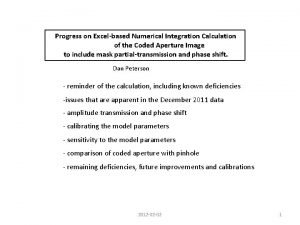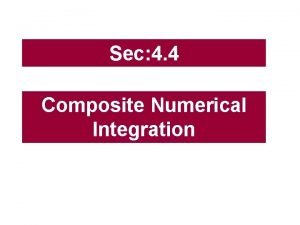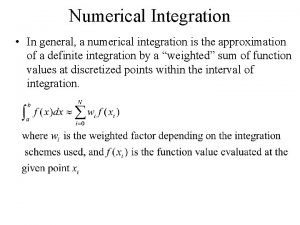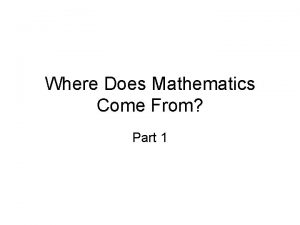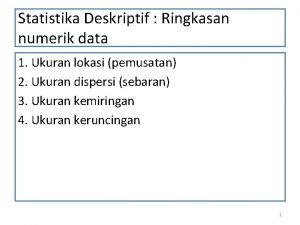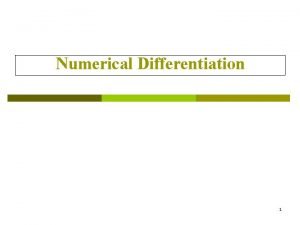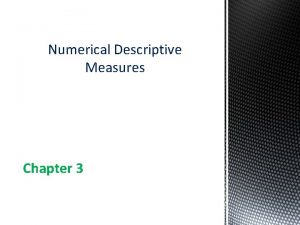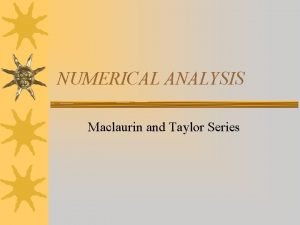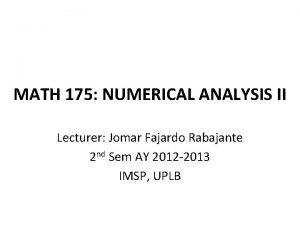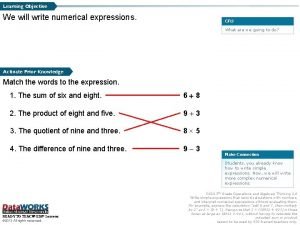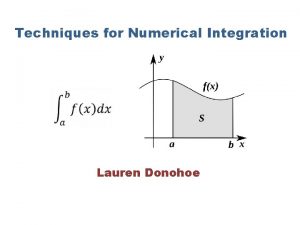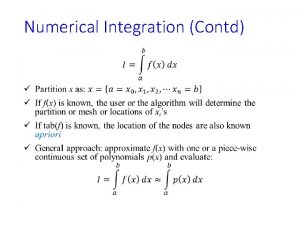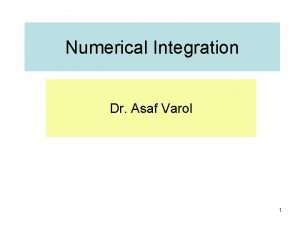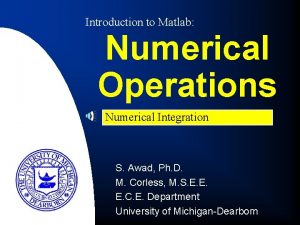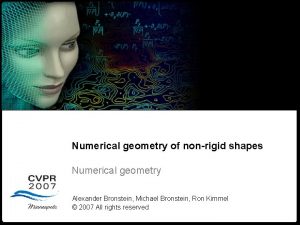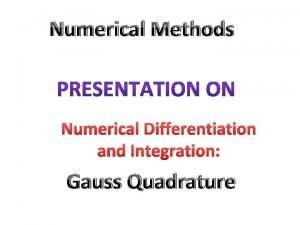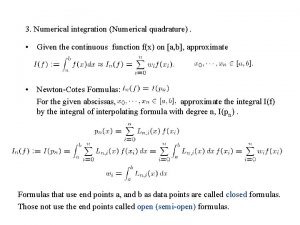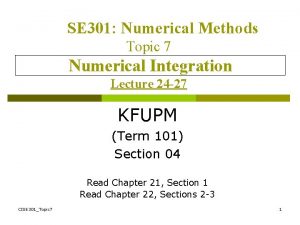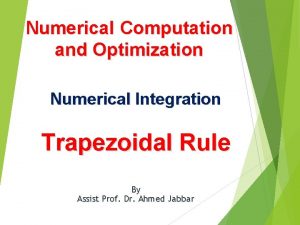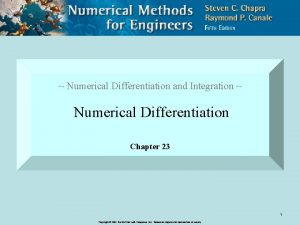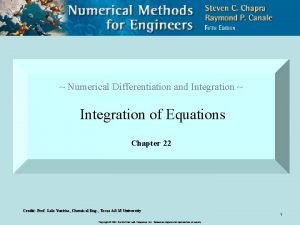Numerical Integration 1 Introduction to Numerical Integration p
































- Slides: 32

Numerical Integration 1

Introduction to Numerical Integration p p p Definitions Upper and Lower Sums Trapezoid Method (Newton-Cotes Methods) 2

Integration Indefinite Integrals Definite Integrals Indefinite Integrals of a function are functions that differ from each other by a constant. Definite Integrals are numbers. 3

Fundamental Theorem of Calculus 4

The Area Under the Curve One interpretation of the definite integral is: Integral = area under the curve f(x) a b 5

Upper and Lower Sums The interval is divided into subintervals. f(x) a b 6

Upper and Lower Sums f(x) CISE 301_Topic 7 a b 7

Example 8

Example 9

Upper and Lower Sums • Estimates based on Upper and Lower Sums are easy to obtain for monotonic functions (always increasing or always decreasing). • For non-monotonic functions, finding maximum and minimum of the function can be difficult and other methods can be more attractive. 10

Newton-Cotes Methods In Newton-Cote Methods, the function is approximated by a polynomial of order n. p Computing the integral of a polynomial is easy. p 11

Newton-Cotes Methods n Trapezoid Method (First Order Polynomials are used) n Simpson 1/3 Rule (Second Order Polynomials are used) 12

Trapezoid Method p p Derivation-One Interval Multiple Application Rule Estimating the Error Recursive Trapezoid Method 13

Trapezoid Method f(x) 14

Trapezoid Method Derivation-One Interval 15

Trapezoid Method f(x) 16

Trapezoid Method Multiple Application Rule f(x) x a b 17

Trapezoid Method General Formula and Special Case 18

Example Given a tabulated values of the velocity of an object. Time (s) 0. 0 1. 0 2. 0 3. 0 Velocity (m/s) 0. 0 10 12 14 Obtain an estimate of the distance traveled in the interval [0, 3]. Distance = integral of the velocity 19

Example 1 Time (s) 0. 0 1. 0 2. 0 3. 0 Velocity (m/s) 0. 0 10 12 14 20

Error in estimating the integral Theorem CISE 301_Topic 7 21

Estimating the Error For Trapezoid Method 22

Example 23

Example x 1. 0 1. 5 2. 0 2. 5 3. 0 f(x) 2. 1 3. 2 3. 4 2. 8 2. 7 24

Example x 1. 0 1. 5 2. 0 2. 5 3. 0 f(x) 2. 1 3. 2 3. 4 2. 8 2. 7 25

Recursive Trapezoid Method f(x) 26

Recursive Trapezoid Method f(x) Based on previous estimate Based on new point 27

Recursive Trapezoid Method f(x) Based on previous estimate Based on new points 28

Recursive Trapezoid Method Formulas 29

Recursive Trapezoid Method 30

Example on Recursive Trapezoid n h R(n, 0) 0 (b-a)= /2 ( /4)[sin(0) + sin( /2)]=0. 785398 1 (b-a)/2= /4 R(0, 0)/2 + ( /4) sin( /4) = 0. 948059 2 (b-a)/4= /8 R(1, 0)/2 + ( /8)[sin( /8)+sin(3 /8)] = 0. 987116 3 (b-a)/8= /16 R(2, 0)/2 + ( /16)[sin( /16)+sin(3 /16)+sin(5 /16)+ sin(7 /16)] = 0. 996785 Estimated Error = |R(3, 0) – R(2, 0)| = 0. 009669 31

Advantages of Recursive Trapezoid: p Gives the same answer as the standard Trapezoid method. p Makes use of the available information to reduce the computation time. p Useful if the number of iterations is not known in advance. 32
 Numerical integration ppt
Numerical integration ppt Numerical integration excel
Numerical integration excel Composite numerical integration
Composite numerical integration C++ program for numerical differentiation
C++ program for numerical differentiation Asu
Asu Simpson one third rule
Simpson one third rule C programming and numerical analysis an introduction
C programming and numerical analysis an introduction Three dimensions of corporate strategy
Three dimensions of corporate strategy Backwards intergration
Backwards intergration Simultaneous integration examples
Simultaneous integration examples Principles of data integration
Principles of data integration Introduction to data integration
Introduction to data integration Numerical expression and equation
Numerical expression and equation Numerical stroop
Numerical stroop Numerical aperture of optical fiber
Numerical aperture of optical fiber Numerical summary of data
Numerical summary of data Counterdisciplinary
Counterdisciplinary Numerical coefficient
Numerical coefficient Numerical patterns
Numerical patterns Graphical method numerical analysis
Graphical method numerical analysis Numerical computing with python
Numerical computing with python Percent difference
Percent difference What is the lower quartile measure of this box plot?
What is the lower quartile measure of this box plot? Numerical descriptive measures exercises
Numerical descriptive measures exercises Newton gregory forward interpolation formula can be used
Newton gregory forward interpolation formula can be used Taylor series numerical methods
Taylor series numerical methods Turner syndrome is what numerical chromosome disorder?
Turner syndrome is what numerical chromosome disorder? Numerical analysis formula
Numerical analysis formula Dark field microscopy
Dark field microscopy What are numerical expressions
What are numerical expressions What is numerical discrete
What is numerical discrete Numerical aperture in microscope
Numerical aperture in microscope Visual numerical learning style
Visual numerical learning style

